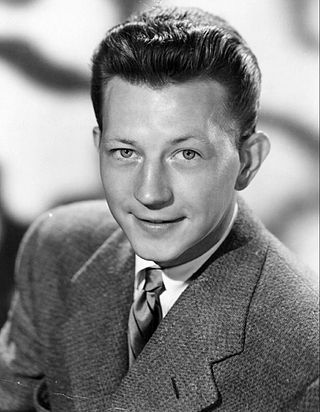
Donald David Dixon Ronald O'Connor was an American dancer, singer and actor. He came to fame in a series of films in which he co-starred, in succession, with Gloria Jean, Peggy Ryan, and Francis the Talking Mule.
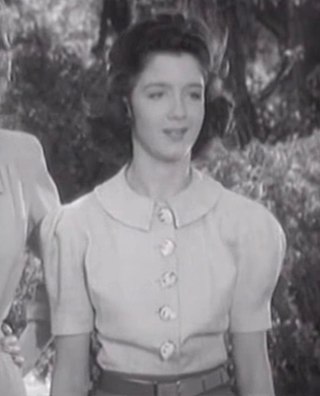
Margaret O'Rene Ryan was an American dancer and actress, best known for starring in a series of movie musicals at Universal Pictures with Donald O'Connor and Gloria Jean.
The Our Gang personnel page is a listing of the significant cast and crew from the Our Gang short subjects film series, originally created and produced by Hal Roach which ran in movie theaters from 1922 to 1944.

Gloria Jean was an American actress and singer who starred or co-starred in 26 feature films from 1939 to 1959, and made numerous radio, television, stage, and nightclub appearances. She may be best remembered for her appearance with W. C. Fields in the film Never Give a Sucker an Even Break (1941).

Follow the Boys also known as Three Cheers for the Boys is a 1944 musical film made by Universal Pictures during World War II as an all-star cast morale booster to entertain the troops abroad and the civilians at home. The film was directed by A. Edward "Eddie" Sutherland and produced by Charles K. Feldman. The movie stars George Raft and Vera Zorina and features Grace McDonald, Charles Grapewin, Regis Toomey and George Macready. At one point in the film, Orson Welles saws Marlene Dietrich in half during a magic show. W.C. Fields, in his first movie since 1941, performs a classic pool-playing presentation he first developed in vaudeville four decades earlier in 1903.
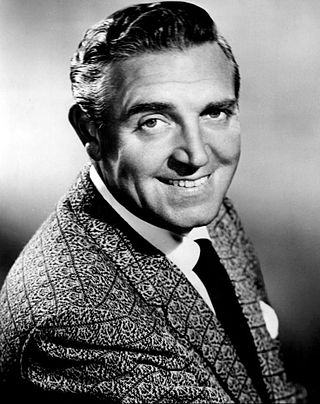
Robert Paige was an American actor and a TV newscaster and political correspondent and Universal Pictures leading man who made 65 films in his lifetime.

The Loss of a Teardrop Diamond is a 2008 independent film by director Jodie Markell. It is based on Tennessee Williams' long-forgotten 1957 screenplay, and stars Bryce Dallas Howard in the leading role of Fisher Willow. The film was released on December 30, 2009, making it the last film to be released in the 2000s.
The House Without a Christmas Tree is a 1972 television movie, novelized into a children's book by Gail Rock in 1974, that centers on the relationship between Adelaide "Addie" Mills, a bright and energetic only child, and her melancholy father, James Addison Mills III. James had never recovered from the death of his wife Helen, and is bitterly against ever having a Christmas tree in the house. The videotaped production was seen regularly on CBS during the holiday season between 1972 and 1977.
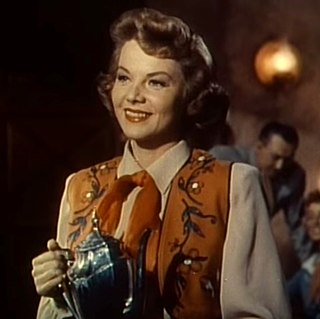
Mary Jane Frehse, was an American actress, singer, and dancer.

When Johnny Comes Marching Home is a 1942 musical film directed by Charles Lamont and starring Allan Jones and Jane Frazee. The film is loosely based on the song with the same title.
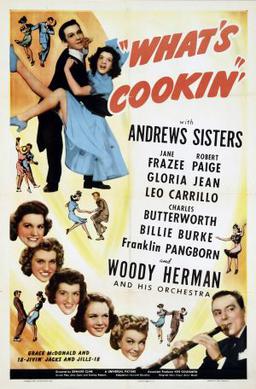
What's Cookin'? is a 1942 American musical film directed by Edward F. Cline and starring The Andrews Sisters, Jane Frazee, Robert Paige and Gloria Jean. The film is based on the story Wake Up and Dream written by Edgar Allan Woolf.

Almost Married is a 1942 American comedy musical film directed by Charles Lamont and starring Jane Frazee.
Mister Big is a 1943 musical directed by Charles Lamont, starring Donald O'Connor, Gloria Jean and Peggy Ryan. The film features the song "Rude, Crude, and Unattractive".
It Comes Up Love is a 1943 American, black and white, musical comedy starring Gloria Jean, Ian Hunter, and Donald O'Connor. It is the only film starring Jean and O'Connor that doesn't also star Peggy Ryan, another one of the talented teenagers at Universal Studios.

Top Man is a 1943 American black-and-white musical comedy film directed by Charles Lamont and starring Donald O'Connor, Susanna Foster, Lillian Gish, Richard Dix, and Peggy Ryan. It was O'Connor and Ryan's first film away from the third of their trio, Gloria Jean.
This Is the Life is a 1944 American musical romantic comedy film directed by Felix E. Feist starring Donald O'Connor, Susanna Foster, and Peggy Ryan. It is one of the several films that Universal Studios rushed O'Connor and Ryan through before O'Connor was drafted into the Army to serve in World War II.

The Merry Monahans is a 1944 American comedy-drama musical film directed by Charles Lamont and starring Donald O'Connor, Peggy Ryan and Jack Oakie.

Patrick the Great is a 1945 American drama film starring Donald O'Connor, Peggy Ryan, and Frances Dee. This was the last film for O'Connor and Ryan together, who had been a teenage team for the past several years. This was also O'Connor's last film before he went to serve in World War II.

The Buster Keaton Story is a 1957 American biographical drama film directed by Sidney Sheldon and written by Sidney Sheldon and Robert Smith, following the life of Buster Keaton. The film stars Donald O'Connor, Ann Blyth, Rhonda Fleming, Peter Lorre, Larry Keating and Jackie Coogan. It was released on April 21, 1957, by Paramount Pictures. The film was described by AllMovie as "sublimely inaccurate" regarding details of Keaton's life. It was produced by Paramount Pictures, which paid Keaton $50,000 for the rights to his life story.
The Jivin' Jacks and Jills were a twentieth century American dance group of the World War II era.














